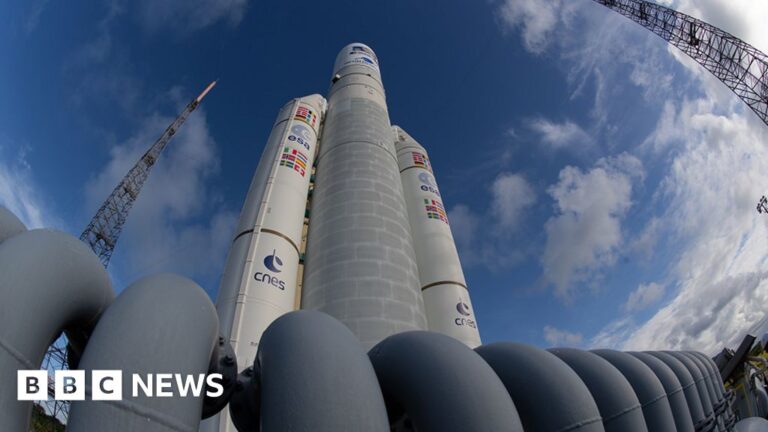- By Jonathan Amos
- BBC Science Correspondent
image source, Stephane Corvaja/ESA
The Ariane rocket is ready to resume launching Juice
The European Space Agency will make another attempt on Friday to launch the Jupiter Icy Moons Explorer (Juice).
Thursday’s bid was hampered by concerns about lightning at the Kourou spaceport in French Guiana.
The juice is sent to the largest planet in the Solar System to study its main moons – Callisto, Ganymede and Europa – all of which are thought to retain vast reservoirs of liquid water.
Scientists are intrigued to know if the moons could also host life.
This may sound fanciful. Jupiter is in the cold, outer part of the Solar System, far from the Sun and receives only a twenty-fifth of the light that falls on Earth.
But the gravitational squeezing the gas giant planets do on their moons means they have the potential to have the energy and heat to drive simple ecosystems – such as those that exist around volcanic vents on the ocean floor of Earth.
“In the case of Europa, there is thought to be a deep ocean, perhaps 100km deep, beneath its ice crust,” said mission scientist Prof Emma Bunce from Leicester University, UK.
“That ocean is 10 times deeper than the deepest ocean on Earth, and the ocean interacts, we think, with a rocky floor. So that provides a scenario where there’s mixing and some interesting -willing chemistry,” the researcher told BBC News.
The Juice spacecraft is carrying 10 instruments to study Jupiter’s moons
Lift-off for the six-tonne Juice spacecraft is scheduled for 09:14 local time in Kourou (13:14 BST).
The Ariane rocket that will carry the mission into the sky has an instant launch window, meaning it must be down to earth until the second the computers demand.
The precision will make it easier to keep the mission on track as it makes its long journey to Jupiter.
Ariane doesn’t have the power to send Juice directly to its destination, not even in a useful timeframe.
Instead, the rocket will send the spacecraft on a path around the inner Solar System. A series of fly-bys of Venus and Earth will gravity hurl the mission toward its intended destination.
It is a 6.6 billion km journey that takes 8.5 years. Arrival in the Jovian system is expected in July 2031.
Carole Mundell: “Liquid water we think is a precondition for habitability”
The ice-covered moons Callisto, Ganymede and Europa were discovered by Italian astronomer Galileo Galilei in 1610, using a recently invented telescope. He sees them as tiny dots swirling around Jupiter. (He also sees a fourth body that we now know as Io, a smaller world covered in volcanoes).
The icy trio ranges in diameter from 4,800km to 5,300km. To put this in context, Earth’s natural satellite is about 3,500km across.
Juice will study the moons remotely. That is to say, it will fly over them; it won’t make it. Ganymede – the largest moon in the Solar System – is the satellite’s ultimate target. It will end its tour by going into orbit around the world in 2034.
Radar will be used to see the moon; The lidar, a laser measuring device, will be used to create 3D maps of their surfaces; magnetometers will probe their complex electrical and magnetic environment; and other sensors will collect data on the orbiting particles that surround the moons. Cameras, of course, will send countless pictures.
Juice will not search for specific “biomarkers” or attempt to find alien fish in the ocean depths.
Its task is to gather more information about habitability so that future missions can more directly address the question of life.
Scientists are already thinking about how they can put landers on one of Jupiter’s icy moons to drill through its crust to water beneath.
In Earth’s Antarctica, researchers are using heat to drill holes hundreds of meters into the ice surface to deploy submersibles in areas where the local ocean is frozen.
This is challenging work and would be an even bigger task on a Jovian moon where the ice crust can be tens of kilometers thick.
Juice doesn’t do its job alone.
The US space agency NASA is sending its own satellite called Clipper.
Although it will leave Earth after Juice, next year, it should arrive before its European sibling. It has the advantage of a more powerful launch rocket.
Clipper will focus its investigations on Europe, but will do the same work.
“There is great complementarity and the teams are keen to work together,” said Prof Carole Mundell, the director of science at the European Space Agency.
“Certainly, there will be a wealth of data. But, first, we need to make sure that our missions can reach Jupiter and operate safely,” he told BBC News.
image source, NASA/JPL-Caltech/SWRI/MSSS
The American Clipper mission should launch in 2024 and focus on Europe
